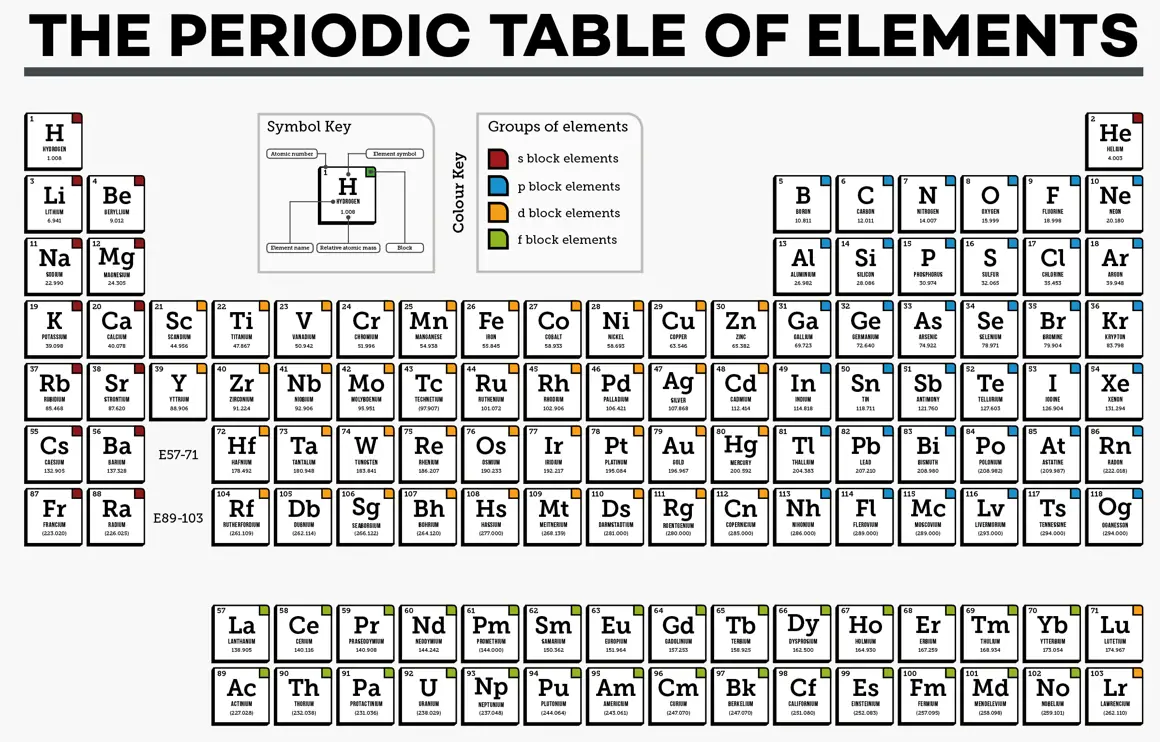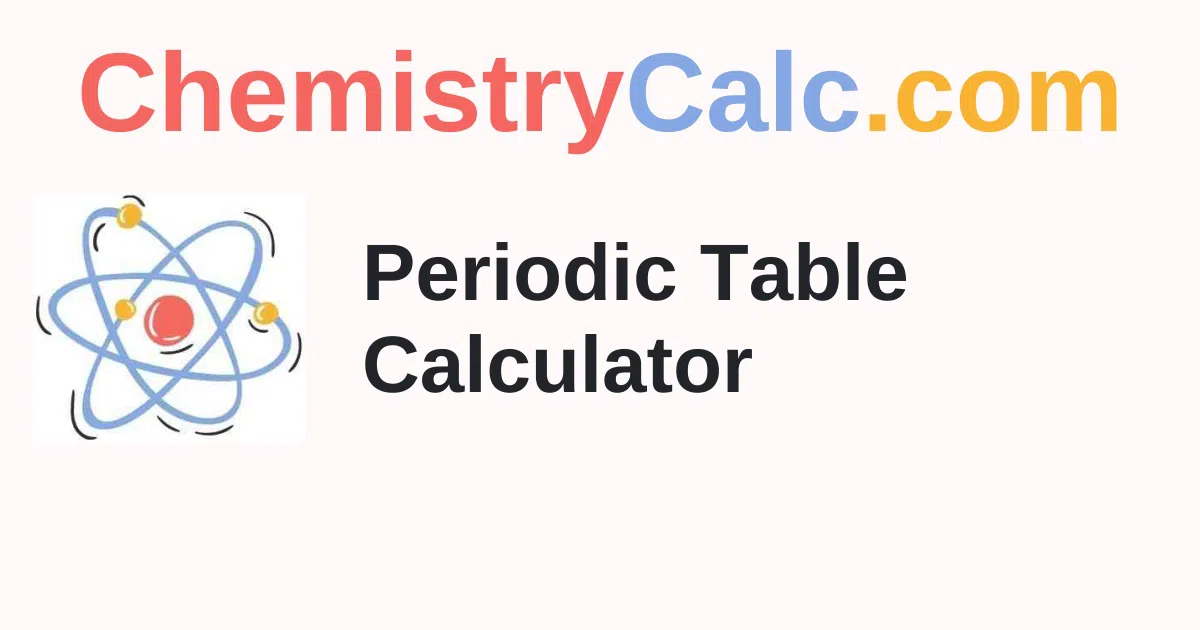Periodic Table Calculator
Periodic Table Calculator gives the atomic number, atomic weight, atomic properties, nuclear properties, electromagnetic properties and others. You just need to provide the chemical name of the element in the input field and press the calculate button to check the result.
| solid | liquid | Periodic Table | gas | synth | |||||||||||||||
| Name:Invented By: | |||||||||||||||||||
| 1 H |
AtomicWeight: Melt|Boil(C): | 2 He |
|||||||||||||||||
| 3 Li |
4 Be |
Shell: Isotopes: | 5 B |
6 C |
7 N |
8 O |
9 F |
10 Ne |
|||||||||||
| 11 Na |
12 Mg |
Orbital: SpecificGravity: | 13 Al |
14 Si |
15 P |
16 S |
17 Cl |
18 Ar |
|||||||||||
| 19 K |
20 Ca |
21 Sc |
22 Ti |
23 V |
24 Cr |
25 Mn |
26 Fe |
27 Co |
28 Ni |
29 Cu |
30 Zn |
31 Ga |
32 Ge |
33 As |
34 Se |
35 Br |
36 Kr |
||
| 37 Rb |
38 Sr |
39 Y |
40 Zr |
41 Nb |
42 Mo |
43 Tc |
44 Ru |
45 Rh |
46 Pd |
47 Ag |
48 Cd |
49 In |
50 Sn |
51 Sb |
52 Te |
53 I |
54 Xe |
||
| 55 Cs |
56 Ba |
57 La |
72 Hf |
73 Ta |
74 W |
75 Re |
76 Os |
77 Ir |
78 Pt |
79 Au |
80 Hg |
81 Tl |
82 Pb |
83 Bi |
84 Po |
85 At |
86 Rn |
||
| 87 Fr |
88 Ra |
89 Ac |
104 Rf |
105 Db |
106 Sg |
107 Bh |
108 Hs |
109 Mt |
110 Uun |
111 Uuu |
112 Uub |
113 Uut |
114 Uuq |
||||||
| Lanthanides | 58 Ce |
59 Pr |
60 Nd |
61 Pm |
62 Sm |
63 Eu |
64 Gd |
65 Tb |
66 Dy |
67 Ho |
68 Er |
69 Tm |
70 Yb |
71 Lu |
|||||
| Actinides | 90 Th |
91 Pa |
92 U |
93 Np |
94 Pu |
95 Am |
96 Cm |
97 Bk |
98 Cf |
99 Es |
100 Fm |
101 Md |
102 No |
103 Lr |
|||||
Periodic Table Definition
The periodic table is the arrangement of all elements known to man in the increasing order of the atomic number and recurring chemical properties. The row in a table is a period and the column is a group.
The elements are arranged from left to right and top to bottom in the order of their increasing atomic numbers. The elements in the same group will have the same valence and chemical properties. And elements in the same period will have an increasing order of valence electrons.
What are the Periodic Table Elements?
The periodic table has a total of 118 elements in it. the first 94 elements are naturally occurring and the remaining have only been synthesized in laboratories. The atomic numbers, chemical element symbols and names are included here.
| 1: H-Hydrogen | 2: He-Helium | 3: Li-Lithium |
| 4: Be-Beryllium | 5: B-Boron | 6: C-Carbon |
| 7: N-Nitrogen | 8: O-Oxygen | 9: F-Fluorine |
| 10: Ne-Neon | 11: Na-Sodium | 12: Mg-Magnesium |
| 13 : Al-Aluminum | 14 : Si-Silicon | 15 : P-Phosphorus |
| 16 : S-Sulfur | 17 : Cl-Chlorine | 18 : Ar-Argon |
| 19 : K-Potassium | 20 : Ca-Calcium | 21 : Sc-Scandium |
| 22 : Ti-Titanium | 23 : V-Vanadium | 24 : Cr-Chromium |
| 25 : Mn-Manganese | 26 : Fe-Iron | 27 : Co-Cobalt |
| 28 : Ni-Nickel | 29 : Cu-Copper | 30 : Zn-Zinc |
| 31 : Ga-Gallium | 32 : Ge-Germanium | 33 : As-Arsenic |
| 34 : Se-Selenium | 35 : Br-Bromine | 36 : Kr-Krypton |
| 37 : Rb-Rubidium | 38 : Sr-Strontium | 39 : Y-Yttrium |
| 40 : Zr-Zirconium | 41 : Nb-Niobium | 42 : Mo-Molybdenum |
| 43 : Tc-Technetium | 44 : Ru-Ruthenium | 45 : Rh-Rhodium |
| 46 : Pd-Palladium | 47 : Ag-Silver | 48 : Cd-Cadmium |
| 49 : In-Indium | 50 : Sn-Tin | 51 : Sb-Antimony |
| 52 : Te-Tellurium | 53 : I-Iodine | 54 : Xe-Xenon |
| 55 : Cs-Cesium | 56 : Ba-Barium | 57 : La-Lanthanum |
| 58 : Ce-Cerium | 59 : Pr-Praseodymium | 60 : Nd-Neodymium |
| 61 : Pm-Promethium | 62 : Sm-Samarium | 63 : Eu-Europium |
| 64 : Gd-Gadolinium | 65 : Tb-Terbium | 66 : Dy-Dysprosium |
| 67 : Ho-Holmium | 68 : Er-Erbium | 69 : Tm-Thulium |
| 70 : Yb-Ytterbium | 71 : Lu-Lutetium | 72 : Hf-Hafnium |
| 73 : Ta-Tantalum | 74 : W-Tungsten | 75 : Re-Rhenium |
| 76 : Os-Osmium | 77 : Ir-Iridium | 78 : Pt-Platinum |
| 79 : Au-Gold | 80 : Hg-Mercury | 81 : Tl-Thallium |
| 82 : Pb-Lead | 83 : Bi-Bismuth | 84 : Po-Polonium |
| 85 : At-Astatine | 86 : Rn-Radon | 87 : Fr-Francium |
| 88 : Ra-Radium | 89 : Ac-Actinium | 90 : Th-Thorium |
| 91 : Pa-Protactinium | 92 : U-Uranium | 93 : Np-Neptunium |
| 94 : Pu-Plutonium | 95 : Am-Americium | 96 : Cm-Curium |
| 97 : Bk-Berkelium | 98 : Cf-Californium | 99 : Es-Ensteinium |
| 100 : Fm-Fermium | 101 : Md-Mendelevium | 102 : No-Nobelium |
| 103 : Lr-Lawrencium | 104 : Rf-Rutherfordium | 105 : Db-Dubnium |
| 106 : Sg-Seaborgium | 107 : Bh-Bohrium | 108 : Hs-Hassium |
| 109 : Mt-Meitnerium | 110 : Ds-Darmstadtium | 111 : Rg-Roentgenium |
| 112 : Cn-Copernicium | 113 : Nh-Nihonium | 114 : Fl-Flerovium |
| 115 : Mc-Moscovium | 116 : Lv-Livermorium | 117 : Ts-Tennessine |
| 118 : Og-Oganesson |
The periodic table image provided here gives the complete information about it.

If you would like to learn more about the other chemical calculator that gives instant results, stay tuned to Chemistrycalc.Com
FAQ’s on Periodic Table Calculator
1. What are the first 10 elements in the periodic table?
The first 10 elements in the periodic table are Hydrogen (H), Helium (He), Lithium (Li), Berylium (Be), Boron (B), Carbon (C), Nitrogen (N), Oxygen (O), Fluorine (F), Neon (Ne).
2. What is meant by the periodic table?
A periodic table is a table that has chemical elements and those are arranged in an order of increasing atomic number.
3. What is the use of the period table of elements calculator?
The free period table calculator makes use of the chemical name of the element to produce its position in the table, basic elemental properties, reactivity, material properties, electromagnetic properties, atomic properties, abundances, identifiers and nuclear properties.
4. How many elements are there in a periodic table?
A period table has 118 elements.

